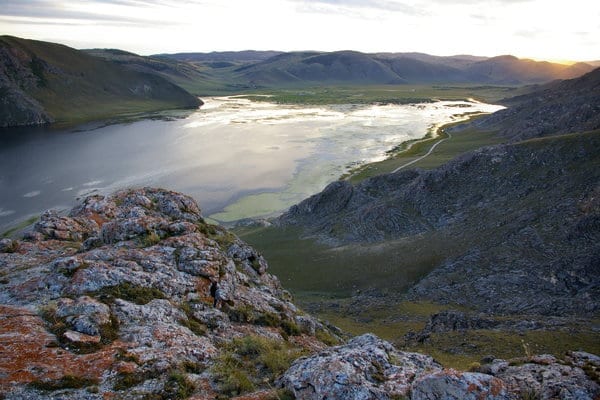24,000-year-old body is kin to both Europeans and North American First Nations – Nov. 20, 2013 New York Times
The Nov. 20, 2013 New York Times article – entitled: “24,000-Year-Old Body Is Kin to Both Europeans and American Indians” – begins as follows:

A view of Lake Baikal in eastern Siberia near where the young boy buried at Mal’ta was discovered. Photo: Nobe Thompson. New York Times, Nov. 20, 2013. The photo is from the article featured at the post you are now reading.
- The genome of a young boy buried at Mal’ta near Lake Baikal in eastern Siberia some 24,000 years ago has turned out to hold two surprises for anthropologists.
- The first is that the boy’s DNA matches that of Western Europeans, showing that during the last Ice Age people from Europe had reached farther east across Eurasia than previously supposed. Though none of the Mal’ta boy’s skin or hair survive, his genes suggest he would have had brown hair, brown eyes and freckled skin.
- The second surprise is that his DNA also matches a large proportion — some 25 percent — of the DNA of living Native Americans. The first people to arrive in the Americas have long been assumed to have descended from Siberian populations related to East Asians. It now seems that they may be a mixture between the Western Europeans who had reached Siberia and an East Asian population.
[End of excerpt]
Comment
You can access the New York Times article here.
Updates
A Nov. 20, 2013 New Scientist article is entitled: “Oldest human genome reveals roots of first Americans.”
A Feb. 12, 2014 CBC article is entitled: “Ancient toddler’s remains re-ignite Native origins debate: Genetic data of skeleton confirms boy’s ancestors orignated from Asia, researcher says.”
A May 16, 2014 CBC article is entitled: “First North Americans’ origins confirmed by ancient teen’s DNA: Girl who fell into deep hole 13,000 years ago is related to modern aboriginal people.”
A June 30, 2014 CBC article is entitled: “Ancient Inuit hunting camp to be uncovered in Manitoba:
1,000-year-old tent rings, as well as food caches, burial grounds and kayak rests can be seen at the site.”
An Aug. 28, 2014 CBC article is entitled: “Inuit were not the first people to settle in the Arctic: DNA research confirms Inuit oral history of the Tunit people.”
A Sept. 29, 2014 Globe and Mail article is entitled: “Underwater discovery near Haida Gwaii could rewrite human history.”
A Dec. 3, 2014 Guardian article is entitled:”World’s earliest known engraving reveals sophistication of Homo erectus.” Th subhead reads: “Discovery of 430,000-year-old shell doodle ‘rewrites human history’ and suggests our ancestors had considerable manual dexterity, say researchers.”
A Dec. 22, 2014 NPR article is entitled: “When Humans Quit Hunting And Gathering, Their Bones Got Wimpy.” the article notes: “The lightweight bones don’t appear until about 12,000 years ago. That’s right when humans were becoming less physically active because they were leaving their nomadic hunter-gatherer life behind and settling down to pursue agriculture.”
An April 15, 2016 Globe and Mail article by Bob Rae is entitled: “Attawapiskat is not alone: Suicide crisis is national problem.”
An Aug. 10, 2016 CBC article is entitled: “Popular theory on how humans populated North America can’t be right, study shows.”
An Aug. 22, 2016 Toronto Star article is entitled: “Sixties Scoop survivors’ day in court finally arrives Tuesday: Indigenous Canadians taken from their homes and their culture suing Ottawa, decades later, over the federal government’s duty to them.”
A Sept. 27, 2016 CBC article is entitled: “Prince William gets lesson in colonialism, cultural genocide at Black Rod ceremony: ‘The current Crown approach of deny and delay cannot continue,’ Grand Chief Ed John tells Prince William.”
An April 23, 2017 Big Think article is entitled: “Discovery of North America’s Oldest Settlement Proves Native Canadian Legend True.”
An April 26, 2017 CBC article is entitled: “Scientists find evidence that humans were in North America 100,000 years earlier than believed: Researchers basing opinion on tools found next to mastodon site in San Diego.”
An April 26, 2017 Atlantic article is entitled: “A New Study Says Humans Were in America 130,000 Years Ago: That’s 100,000 years earlier than previously thought—and most archaeologists aren’t buying it.
An April 26, 2017 Canadian Art article is entitled: “Video: In the Studio with Kent Monkman.”
A March 28, 2018 Guardian article is entitled: “Prehistoric human footprints unearthed on Canada shoreline: Scientists find 29 prints on island in British Columbia, supporting theory that early Americans arrived from Asia.”

Leave a Reply
Want to join the discussion?Feel free to contribute!